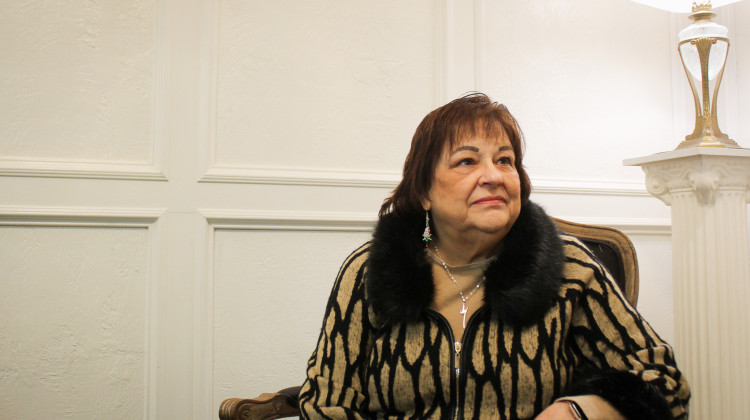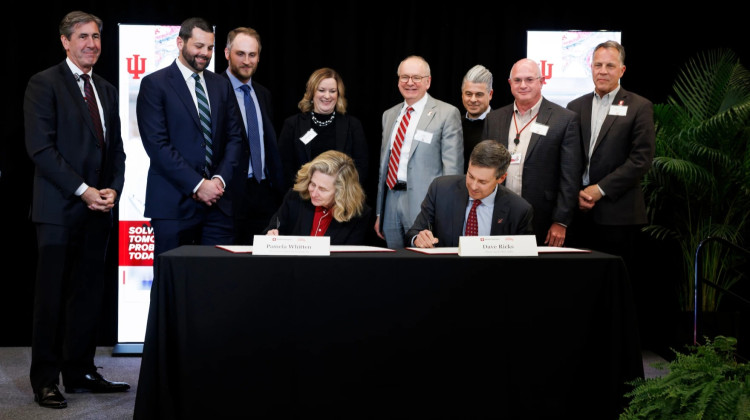
Henry Jones, 72, sits at an office at Christ House, a medical respite facility in Washington, D.C., on April 5, 2022.
Ryan Levi / TradeoffsRyan Levi - Tradeoffs
Henry Jones felt like he was at the end of the line in the summer of 1991.
“There was no way out,” he remembered thinking. “I prayed and was tired, but I couldn’t see no way out.”
Jones had been homeless in Washington, D.C., for 11 years, and the years had taken their toll.
“I started to get sicker and sicker, and my legs started giving out on me,” he said. “I could feel my health failing.”
One hot morning in June, Jones was in particularly rough shape — his legs ached, his stomach hurt and his arms were trembling. A security guard had to give him a ride from the hospital parking lot to the emergency room because he could barely stand.
The hospital wouldn’t admit him, but a social worker referred him to a place called Christ House, a facility for men without homes who were too sick to be on the streets or in a shelter, but not sick enough to require hospital-level care.
“We saw sick homeless persons getting worse and worse who were out on the street,” said Dr. Janelle Goetcheus, who started the 34-bed facility in 1985. “So we just wanted to have a place where they could come and be cared for.”
By the time Henry Jones arrived in 1991, Christ House was admitting more than 300 people a year.

“I couldn’t believe what I was seeing,” Jones said, remembering his first day. “I was sleeping in a nice, clean bed. I was getting some good food to eat. The nurses and the doctors, they were so concerned. They just wanted me to get better, and I could see that.”
Today, programs like Christ House that provide short-term medical care for homeless people are known as medical respite or recuperative care. The decades-old concept has taken off in recent years due to worsening homelessness, greater attention to the relationship between housing and health and increased interest from private insurers.
Christ House was one of the first, and it’s now one of 133 programs spread across 37 states and Washington, D.C., that offer homeless people a safe place to recover from surgery or other acute illness, learn to manage a chronic condition, and get help finding permanent housing.
Medical respite is on the rise, fueled by private Medicaid plans
Medical respite programs are unregulated and unlicensed, and they often look incredibly different from one another, said Julia Dobbins, director of medical respite for the National Health Care for the Homeless Council.
The most common setting is a homeless shelter — a few beds or a room set aside with a nurse coming by to check in once a day. Others, like Christ House, have their own building and include full-service kitchens, social spaces, exam rooms and round-the-clock medical care.
The number of medical respite homes has more than doubled over the past seven years, driven by multiple factors.
First, the number of homeless people grew every year from 2016 to 2020, topping out at nearly 600,000, according to estimates from the U.S. Department of Housing and Urban Development. The homeless population is also getting older and sicker. Research shows homeless people in their 50s are in worse health than folks in their 70s who have a place to live, and half of homeless adults are over 50.
At the same time, doctors, health care executives and state and federal policymakers have begun to accept that non-medical factors like housing impact people’s well-being, and that the health care industry should do something about it.
Perhaps the most surprising driver of medical respite’s growth is interest from managed care organizations — the private insurance companies that cover 7 in 10 people on Medicaid.
Most medical respite programs have multiple funding sources. Hospitals, philanthropies and state and local governments have historically been the most common, but about 1 in 3 programs now receive some funding from Medicaid plans.
Dobbins said this started when the Affordable Care Act allowed 38 states and Washington, D.C., to expand Medicaid to low-income adults with no children, bringing thousands of previously ineligible homeless individuals onto Medicaid.
Many state Medicaid programs are simultaneously pressuring managed care organizations to cut expensive avoidable care, pushing more insurers to consider medical respite.
One example is AmeriHealth Caritas DC, one of three managed care plans in Washington, D.C. In 2016, Washington’s Medicaid program started docking insurers’ pay if they failed to reduce hospital readmissions and unnecessary emergency room visits.
AmeriHealth estimated it provided Medicaid benefits to around 3,500 people experiencing homelessness, and some of them used the hospital and ER a lot. The company ran the numbers and was persuaded medical respite could improve people’s health, help the business avoid financial penalties and save up to $200,000 a year.
The company partnered with Volunteers of America Chesapeake & Carolinas, a health and human services agency that was willing to run a new respite facility. Washington’s largest community health center, Unity Health Care, would provide medical care, and a local housing agency, Pathways to Housing DC, would try to connect residents with permanent housing. The daily rate AmeriHealth agreed to pay for its members to stay was enough to fund the entire operation.
The result was Hope Has a Home, two eight-bed medical respite facilities that opened in 2019 and have served more than 60 people so far.
“I thank God for this place,” said Wayne Gaddis, a 58-year-old who came to Hope Has a Home after undergoing spinal surgery. “If I wasn’t here, I would have been on the streets, probably back on drugs, killing myself slowly, not taking my medication, not caring because I feel no one else did care. But this place, it gives me new hope. A new life.”
The need for more evidence
Much of the research and data on medical respite has been self-published by medical respite programs, and no one in the U.S. has conducted a rigorous randomized controlled trial – considered the gold standard for measuring the effectiveness of an intervention.
“Unfortunately, there’s not as much literature in the field as we wish there was,” said Dobbins with the National Health Care for the Homeless Council.
There have been around 20 peer-reviewed articles, which Dobbins’ team reviewed for a recent literature review. That research strongly suggests people who use medical respite spend less time in the hospital, are less likely to be readmitted to the hospital and are more likely to use primary care.
But there’s less evidence on whether medical respite is likely to save insurers money.

Paying a few hundred dollars a day to send someone to medical respite is certainly cheaper than paying thousands of dollars a night for them to stay in the hospital. But it can also extend someone’s life and uncover chronic conditions that will need years of management.
“We cannot underestimate how sick [homeless] folks are,” Dobbins said.
Case in point: AmeriHealth Caritas DC says the first 11 people they sent to Hope Has A Home went to the ER less. But their primary care visits skyrocketed, helping send total costs of care up 75 percent.
It’s just a small sample, and AmeriHealth remains committed to medical respite with plans to launch two facilities for homeless women next year.
“Everything we do might not necessarily have a cost savings,” said Dr. Karyn Wills, chief medical officer for CareFirst, another Washington, D.C., managed care organization that started paying for medical respite in 2021. “It is important, but it’s not our primary driver.”
‘We are not going to end this crisis with medical respite beds alone’
Policymakers in Washington state, Minnesota, Colorado and New York are exploring how they could expand access to medical respite through Medicaid. But a major roadblock remains.
The federal Centers for Medicare & Medicaid Services is forbidden from paying for “room and board,” which has prevented medical respite from being covered by Medicaid the same as other services like a doctor’s visit or nursing home stay.
Managed care organizations have to set up individual contracts with each medical respite provider, and the money they spend on respite isn’t factored into their annual contract negotiations with state Medicaid programs to determine how much state and federal money they receive.
In 2022, California became the first state to get a waiver from CMS allowing medical respite to be a covered benefit. Utah is in the process of getting its own waiver – more evidence that CMS is open to this experiment.
Respite providers, insurance companies, advocates and policymakers agree that a bigger shift in CMS’ policy could open the floodgates to more medical respite. But even if that happens, it will still likely only touch a fraction of the nearly 600,000 homeless people in the country.
“We are not going to end this crisis with medical respite beds alone,” Dobbins said. “Medical respite care is not housing.”
Forty percent of Christ House residents over the last three years have been discharged to a shelter or back on the streets. A similar share at Hope Has a Home also left without finding a stable place to live.
The lack of affordable housing forces respite homes to choose between releasing someone back to homelessness or keeping them in a bed that someone else needs.
“We have to always be talking about access to affordable housing for folks experiencing homelessness,” Dobbins said. “Otherwise, we’re going to just keep talking about developing more and more respite programs. And while I’m here to support them, that is not my goal long term.”
Ryan Levi is a reporter/producer for the Tradeoffs podcast, and Dan Gorenstein is the founder and executive editor of the show, which ran a version of this story on April 28. This story is part of a Tradeoffs series on improving care for people with complex health and social care needs supported by the Better Care Playbook.
Side Effects Public Media is a public health news initiative based at WFYI.
9(MDAyMzk1MzA4MDE2MjY3OTY1MjM5ZDJjYQ000))
 DONATE
DONATE







 Support WFYI. We can't do it without you.
Support WFYI. We can't do it without you.